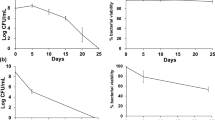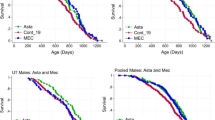Abstract
The effect of E. colicyoA and cydA mutations that diminish the activity of bo' and bd-I terminal oxidases, respectively, on the lifespan of C. elegans nematodes was examined. It was demonstrated that the mean lifespan of the nematodes feeding on the cyoA and cydA mutants increased by 15.5 and 12.8%, respectively. It is known that cyoA and cydA mutants are characterized by the increased level of reactive oxygen species production. It is suggested that the lifespan extension in C. elegans is determined by moderate oxidative stress that occurs in the nematode organism upon culturing on these mutant bacteria.

Similar content being viewed by others
REFERENCES
Clark, L.C. and Hodgkin, J., Commensals in the C. elegans model, Cell. Microbiol., 2014, vol. 16, pp. 27—38. https://doi.org/10.1111/cmi.12234
Zhang, J., Holdorf, A.D., and Walhout, A.J.M.C., C. elegans and its bacterial diet as a model for systems-level understanding of host—microbiota interactions, Curr. Opin. Biotechnol., 2017, vol. 46, pp. 74—80. https://doi.org/10.1016/j.copbio.2017.01.008
Saiki, R., Lunceford, A.L., Bixler, T., et al., Altered bacterial metabolism, not coenzyme Q content, is responsible for the lifespan extension in Caenorhabditis elegans fed an Escherichia coli diet lacking coenzyme Q, Aging Cell, 2008, vol. 7, pp. 291—304. https://doi.org/10.1111/j.1474-9726.2008.00378.x
Virk, B., Correia, G., Dixon, D.P., et al., Excessive folate synthesis limits lifespan in the C. elegans E. coli aging model, BMC Biol., 2012, vol. 10: 67. https://doi.org/10.1186/1741-7007-10-67
Cabreiro, F., Au, C., Leung, K.-Y., et al., Metformin retards aging in C. elegans by altering microbial folate and methionine metabolism, Cell, 2013, vol. 153, pp. 228—239. https://doi.org/10.1016/j.cell.2013.02.035
Gusarov, I., Gautier, L., Smolentseva, O., et al., Bacterial nitric oxide extends the lifespan of C. elegans,Cell, 2013, vol. 152, pp. 818—830. https://doi.org/10.1016/j.cell.2012.12.043
Han, B., Sivaramakrishnan, P., Lin, C.J., et al., Microbial genetic composition tunes host longevity, Cell, 2018, vol. 173, p. 1058. https://doi.org/10.1016/j.cell.2018.04.026
Hoang, K.L., Gerardo, N.M., and Morran, L.T., The effects of Bacillus subtilis on Caenorhabditis elegans fitness after heat stress, Ecol. Evol., 2019, vol. 9, pp. 3491—3499. https://doi.org/10.1002/ece3.4983
Artal-Sanz, M. and Tavernarakis, N., Mechanisms of aging and energy metabolism in Caenorhabditis elegans,IUBMB Life, 2008, vol. 60, pp. 315—322. https://doi.org/10.1002/iub.66
Back, P., Braeckman, B.P., and Matthijssens, F., ROS in aging Caenorhabditis elegans: damage or signaling?, Oxid. Med. Cell Longev., 2012, p. 608478. https://doi.org/10.1155/2012/608478
Scudellari, M., The science myths that will not die, Nature, 2015, vol. 528, pp. 322—325. https://doi.org/10.1038/528322a
Shore, D.E. and Ruvkun, G., A cytoprotective perspective on longevity regulation, Trends Cell Biol., 2013, vol. 23, pp. 409—420. https://doi.org/10.1016/j.tcb.2013.04.007
Ristow, M. and Zarse, K., How increased oxidative stress promotes longevity and metabolic health: the concept of mitochondrial hormesis (mitohormesis), Exp. Gerontol., 2010, vol. 45, pp. 410—418. https://doi.org/10.1016/j.exger.2010.03.014
Lee, S.J., Hwang, A.B., and Kenyon, C., Inhibition of respiration extends C. elegans life span via reactive oxygen species that increase HIF-1 activity, Curr. Biol., 2010, vol. 20, pp. 2131—2136. https://doi.org/10.1016/j.cub.2010.10.057
Schmeisser, S., Schmeisser, K., Weimer, S., et al., Mitochondrial hormesis links low-dose arsenite exposure to lifespan extension, Aging Cell, 2013, vol. 12, pp. 508—517. https://doi.org/10.1111/acel.12076
Van Raamsdonk, J.M. and Hekimi, S., Superoxide dismutase is dispensable for normal animal lifespan, Proc. Natl. Acad. Sci. U.S.A., 2012, vol. 109, pp. 5785—5790. https://doi.org/10.1073/pnas.1116158109
Yang, W. and Hekimi, S., A mitochondrial superoxide signal triggers increased longevity in Caenorhabditis elegans,PLoS Biol., 2010, vol. 8. e1000556. https://doi.org/10.1371/journal.pbio.1000556
Bjelakovic, G., Nikolova, D., Gluudet, L.L., et al., Mortality in randomized trials of antioxidant supplements for primary and secondary prevention: systematic review and meta-analysis, JAMA, 2007, vol. 297, pp. 842—857. https://doi.org/10.1001/jama.297.8.842
García-Horsman, J.A., Barquera, B., Rumbley, J., et al., The superfamily of heme—copper respiratory oxidases, J. Bacteriol., 1994, vol. 176, pp. 5587—5600. https://doi.org/10.1128/jb.176.18.5587-5600.1994
Cotter, P.A., Chepuri, V., Gennis, R.B., and Gunsalus, R.P., Cytochromeo (cyoABCDE) and (cydAB) oxidase gene expression in Escherichia coli is regulated by oxygen, pH, and the fnr gene product, J. Bacteriol., 1990, vol. 172, pp. 6333—6338. https://doi.org/10.1128/jb.172.11.6333-6338.1990
Lindqvist, A., Membrillo-Hernandez, J., Poole, R.K., and Cook, G.M., Roles of respiratory oxidases in protecting Escherichia coli K12 from oxidative stress, Antonie van Leeuwenhoek, 2000, vol. 78, pp. 23—31. https://doi.org/10.1023/A:1002779201379
Brynildsen, M.P., Winkler, J.A., Spina, C.S., et al., Potentiating antibacterial activity by predictably enhancing endogenous microbial ROS production, Nat. Biotechnol., 2013, vol. 31, pp. 160—165. https://doi.org/10.1038/nbt.2458
Baba, T., Ara, T., Hasegawa, M., et al., Construction of Escherichia coli K-12 in-frame, single-gene knockout mutants: the Keio collection, Mol. Syst. Biol., 2006, vol. 2, pp. 2006—2008. https://doi.org/10.1038/msb4100050
Miller, J.H., Experiments in Molecular Genetics, Cold Spring Harbor: Cold Spring Harbor Lab., 1972.
Stiernagle, T., Maintenance of C. elegans, Worm Book: the Online Review of C. elegans Biology, 2006. Accessed February 11, 2006.https://doi.org/10.1895/wormbook.1.101.1
Govindan, J.A., Jayamani, E., Zhang, X., et al., Dialogue between E. coli free radical pathways and the mitochondria of C. elegans,Proc. Natl. Acad. Sci. U.S.A., 2015, vol. 112, pp. 12456—12461. https://doi.org/10.1073/pnas.1517448112
Tapia, P.C., Sublethal mitochondrial stress with an attendant stoichiometric augmentation of reactive oxygen species may precipitate many of the beneficial alterations in cellular physiology produced by caloric restriction, intermittent fasting, exercise and dietary phytonutrients: “mitohormesis” for health and vitality, Med. Hypotheses, 2006, vol. 66, pp. 832—843. https://doi.org/10.1016/j.mehy.2005.09.009
Schulz, T.J., Zarse, K., Voigt, A., et al., Glucose restriction extends Caenorhabditis elegans life span by inducing mitochondrial respiration and increasing oxidative stress, Cell Metab., 2007, vol. 6, pp. 280—293. https://doi.org/10.1016/j.cmet.2007.08.011
Ristow, M. and Schmeisser, K., Mitohormesis: promotimg health and lifespan by increased level of reactive gene species (ROS), Dose—Response, 2014, vol. 12, pp. 288—341. https://doi.org/10.2203/dose-response.13-035.Ristow
Funding
This study was supported by the Russian Science Foundation (grant no. 17-74-30030).
Author information
Authors and Affiliations
Corresponding author
Ethics declarations
Conflicts of interest. The authors declare that they have no conflicts of interest.
Statement on the welfare of animals. All applicable international, national, and/or institutional guidelines for the care and use of animals were followed.
Additional information
Translated by N. Maleeva
Rights and permissions
About this article
Cite this article
Katkova-Zhukotskaya, O.A., Eremina, S.Y., Shakulov, R.S. et al. Culturing Caenorhabditis elegans on Escherichia coli Strains Lacking the Synthesis of bo' and bd-I Terminal Oxidases Extends the Nematode Lifespan. Russ J Genet 55, 1573–1576 (2019). https://doi.org/10.1134/S1022795419120068
Received:
Revised:
Accepted:
Published:
Issue Date:
DOI: https://doi.org/10.1134/S1022795419120068




